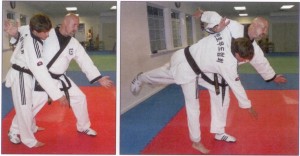By Richard Conceicao, 6thDan
In Koryo there is a pair of extended arm sidekicks followed immediately by a turn and a low strike.These are commonly viewed as two separate techniques to be directed at adversaries approaching from two different directions
I have never been fond of the “multiple opponent” description of the poomse, as I believe it creates more confusion than it clarifies, and feel that it has little historical accuracy. In addition it obscures the grappling and throwing applications that were part of the fighting art, as opposed to the sporting one.So lets take a fresh look at the sequence. We realize from the first picture that the extended arm can’t be used as a simultaneous strike as it is too short. If the kick is hitting its intended target, the arm can’t be anywhere near it. Looking at the second picture, one is struck by the seemingly odd choice of an opening attack or defense. In an attempt to get so low, he risks blocking the next punch with his face!I would like to suggest instead that this is a representation of an inner reaping thigh throw known as an “Uchi Mata”
In the first picture we see the initiation of the throw. What we would normally consider the sidekick is actually placed between the opponents’ legs, and past them. This allows the extended arm to hook on the upper body in any number of places.In the second picture (at the apex of the throw) the leg is fully extended and the throwers body is beginning to turn to the rear. At the completion of the throw he will be facing the rear in exactly the low stance that we see in the form.Not only does this interpretation make sense within the movements of the poomse, it also makes sense combatively.
No longer are we faced with a difficult explanation as to why someone would behave in that manner.I believe the serious practitioner should take a hard look at the various spins and turns found in many forms, and begin to think of them in other ways.
here is video presentation of the technique:
Richard would like to thank Master Mike Barnard and his instructors D. Macri, D. Post, and H. Stehlik of Han Ho Martial Arts for their kind participation. Also Bob Adams of RADesigns for the photography



Hi Richard,
thanks for this article! And it makes even more sense, if one uses
the “official” sequence: from the position before the yopchagi (or
“yopchagi” for application’s sake ;). i.e. jumeok pyojeokjireugi in
juchumseogi with both arms finally extended, step over in kkoaseogi
and do the yopchagi (“yopchagi” ;), while simultaneously pulling in
both hands to the hip (contrary to extending the arm).
Had never seen the yopchagi with extended arm (mejumeok bakkat
chigi) in any Koryo performance before. (“officially” you find it only,
where a palkup pyojeokchigi follows: Taegeuk 5jang, Taebaek and
at the last kick in Pyongwon).
kind regards
peter